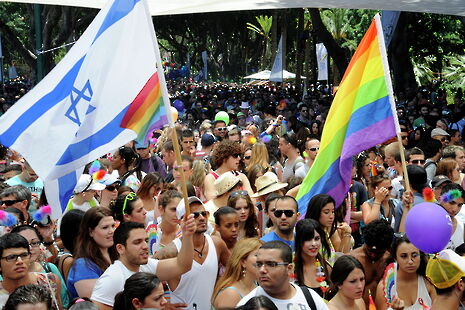‘It’s just a phase’: dispelling the myth
It’s not just a stage of confusion and immaturity. Joel Lucyszyn challenges the lazy stereotype that bisexuality is just something you’ll grow out of

Of all the tacky ‘words of wisdom’ directed at bisexuality, “it’s just a phase” has to be the worst. Whether it be because of the onset of hormones, an exploration of one’s sexuality, or a rebellion against parents, “it’s just a phase” is justified with deploring explanations. Being the most commonplace of biphobic catchphrases, it’s worth looking at why this particular conviction has polluted our discussions of bisexual identity for generations.
The most obvious reason for “it’s just a phase” is homophobia. It’s what heterosexual couples often say and hope for when their child comes out (or is outed) as having same-sex attraction. This is true of gay men and lesbians as it is true of bisexuals – though the case is different with bisexual people. Believing, as many people do, in the false binary of hetero and homosexuality, many parents fall back on the false ‘assurance’ that their bisexual child will one day choose one path or the other – more than likely, they hope for it to be a straight one. Until they reach that end goal they are uncertain: condescended to as floundering and confused, unable to make up their mind or potentially misled by ‘dangerous’ (queer) individuals.
The rhetoric of “it’s just of phase” presents bisexuality as immature. The bisexual experience is falsely aligned with a teenage emotional and hormonal imbalance: easily influenced by the flux of nasty TV-shows, celebrities, friends and music into a mercurial state of mind that is subject to change. Often, this leads to a deeply ingrained sense of uncertainty in bisexual people which persists well into their adult lives, with bisexuals struggling to express their identities because they’ve been told that this indecisive stage would eventually develop into a state of comfortable monosexuality.
“It reinforces and perpetuates the stereotype that bisexuality is just a temporary state”
However, the persistence of “it’s just a phase” is not wholly due to it being forced on unwilling subjects. The phrase has opened up a middle-ground for homosexual men and women, something they can appropriate and use before ‘fully coming out’ to soften the blow. This is most often the case in schools, where bisexuality is used as a stepping stone before identifying as lesbian or gay. When many of these individuals – gradually or suddenly – come out as monosexuals at a later date, it reinforces and perpetuates the stereotype that bisexuality is just a temporary state.
This is damaging to bisexual people, but the onus isn’t completely on gay and lesbian people. Many factors have to be considered, including the obvious fact that feeling the need to ‘soften the blow’ is a product of the homophobic institutions in which queer people have to survive. Additionally, and equally as valid, is the fact that some people genuinely are ‘confused’ or exploring their sexuality, and it takes them time to reach a definition which suites them. The other is more radical: that sexuality shouldn’t have to be considered in a binary of “you’re this or you’re that”, and that often an individual’s sexual preference changes over time.
The rise in the use of ‘queer’ as an identifier for sexual orientation (and gender) is partially a product of this recognition: many people rightly refuse the unfair assumption that one has to disclose a precise definition of their sexuality, preferring to identify in opposition to straightness without ‘specifying’ their preference in romantic or sexual partners. The choice is with the individual, and must come with a mutual and mature agreement to respect the validity of any LGBT+ person without reserve.
Unfortunately, this respect is often not afforded to bisexual people on the same level as lesbians and gay men who, along with heterosexuals, continue to denigrate bisexuality as a phase. New discourses and understandings of sexual identification must be considered with an unreserved recognition of bisexuality as a valid orientation, not as a preceding stage to monosexuality. Statistics foreground the urgency of this recognition: of those who responded to the Office of National Statistics 2015 survey, over a third of LGBT+ individuals in the United Kingdom identified as bisexual. There are more (publicly) bisexual identifying British people than there are lesbians or gay men: it certainly doesn’t look like a phase.
The important element to be gleaned from these surveys and uses of the identifier ‘bisexual’ is that although bisexuality may be appropriated by homosexuals growing up in hostile environments, or ‘replaced’ on a personal level with the use of ‘queer’, this is not because bisexuality is less stable than other sexual identities – and it is certainly not because bisexuality is “just a phase”
 Features / How sweet is the en-suite deal?13 January 2026
Features / How sweet is the en-suite deal?13 January 2026 Comment / Will the town and gown divide ever truly be resolved?12 January 2026
Comment / Will the town and gown divide ever truly be resolved?12 January 2026 News / 20 vet organisations sign letter backing Cam vet course13 January 2026
News / 20 vet organisations sign letter backing Cam vet course13 January 2026 Arts / Fact-checking R.F. Kuang’s Katabasis13 January 2026
Arts / Fact-checking R.F. Kuang’s Katabasis13 January 2026 Music / Inside Radiohead’s circle13 January 2026
Music / Inside Radiohead’s circle13 January 2026









